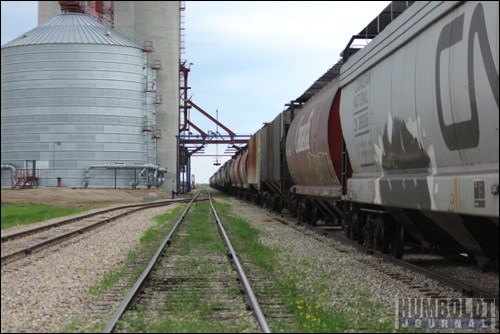What can $6 million buy?
It depends on who you ask, of course, but if you're curious, head east on Highway 5. Stop just a couple kilometres outside of town, at the Viterra grain terminal, and you'll have your answer; three huge cylindrical grain bins and room for almost 40 extra rail cars.
As part of a $20-million expansion at four of its Saskatchewan terminals, Viterra recently committed to doubling storage capacity at the Humboldt facility.
On June 19 that investment was celebrated with a grand reopening, held in the shadow of those new grain bins and only a couple hundred feet from a long line of rail cars. A large blue-and-white tent was pitched in the middle of the parking lot. It sat on damp and muddy ground from the previous night's rain.
About 70 people were on hand to enjoy lunch and listen to remarks from Dean McQueen, Viterra's vice-president of grain merchandising and transportation.
"There's a very good farm base here with outstanding growers that grow good crops," McQueen said after his speech. "It's a consistent production area and that's important to us."
In addition to the new grain bins, the terminal can now handle up to 104 rail cars. The previous maximum was 67.
"It means that we're not relying on the railroad system as regularly, given that we've got a little more space now," McQueen said. "And when we do get those car spots we'll be able to load out more grain at once so that we can generate more space."
In January, Viterra was acquired for $6.1 billion by commodities giant Glencore Xstrata, a company operating in 50 countries and with approximately 190,000 employees. Despite the massive size of its corporate parent, McQueen said it's important for Viterra to stay true to its history.
"This is another facility where we've got our roots laid down," he said. "Humboldt's been a part of our company history for a hundred years probably. We want to operate in communities that have good rail and road infrastructure systems and Humboldt provides that to us.
"Those factors play a part in our decisions as to where we build or expand. The location that Humboldt is, with the crop mix as well as the quality and consistency that's grown in this region really supported our business stability."
On this day, though, the conditions that make the Humboldt area such an attractive growing region were causing problems. Rain from the night before had turned the ground into a soft mix of gravel, mud and grass. While most in the crowd wore work boots, McQueen's dress shoes were flecked with brown muck.
"It's not good for tracking around the yard," he said with a bemused look at his feet, "but hopefully down the line we should see some benefit from these rains - bigger crops hopefully, that will benefit our customers, company and our expanded asset here in Humboldt."




